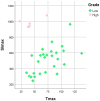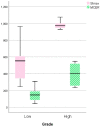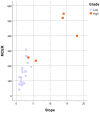Apparent Diffusion Coefficient Values and Dynamic Contrast-Enhanced Magnetic Resonance Perfusion are Potential Predictors for Grading Meningiomas
- PMID: 36035372
- PMCID: PMC9413562
- DOI: 10.7150/ijms.75092
Apparent Diffusion Coefficient Values and Dynamic Contrast-Enhanced Magnetic Resonance Perfusion are Potential Predictors for Grading Meningiomas
Abstract
Purpose: Distinguishing between high-grade and low-grade meningiomas might be difficult but has high clinical value in deciding precise treatment and prognostic factors. Magnetic resonance imaging (MRI) using apparent diffusion coefficient (ADC) values and dynamic contrast enhancement (DCE) may have a significant role in capturing such complexities. Methods: Data from our hospital database on meningioma patients from January 2020 to December 2021 were obtained. The MRI results of all patients were evaluated for mean ADC value and DCE parameters, including time-signal intensity curves (TIC), maximum signal intensity (SImax), time to maximum signal intensity (Tmax), maximum contrast enhancement ratio (MCER), and slope. Results: In this retrospective analysis, 33 individuals were included. Twenty-eight (84.8%) patients were pathologically diagnosed with low-grade meningioma and five (15.2%) patients with high-grade meningioma. There is a crossover between high- and low-grade meningiomas in conventional MRI. Tumor size, location, shape, necrotic/cystic changes, peritumoral edema, and enhancement patterns did not differ substantially between groups (p = 0.39, 0.23, 0.28, 0.57, 0.56, and 0.33, respectively). The mean ADC and Tmax values of high-grade meningiomas were substantially lower than those of low-grade meningiomas (p = 0.002 and 0.02, respectively). An optimal cut-off of 0.87 × 10-3 mm2s-1 for the mean ADC value (area under the curve [AUC] = 0.94, sensitivity = 80%, specificity = 92.8%) and 42 s for Tmax (AUC = 0.84, sensitivity = 80%, specificity = 89.3%) was suggested. High-grade meningiomas had significantly higher TIC, SImax, MCER, and slope than low-grade meningiomas (p = 0.004, < 0.001, 0.01, and 0.001, respectively). Type IV TIC had a sensitivity of 80% and specificity of 89.3% in distinguishing high-grade meningiomas from low-grade meningiomas. Optimal cut-offs of 940.2 for SImax (AUC = 0.98, sensitivity = 80%, specificity = 96.4%), 245% for MCER (AUC = 0.94, sensitivity = 80%, specificity = 85.7%), and 5% per second for slope (AUC = 0.97, sensitivity = 80%, specificity = 96.4%) were estimated. Conclusion: The ADC value and DCE-MRI parameters (TIC, SImax, Tmax, MCER, and slope) are potential predictors for separating high-grade from low-grade meningiomas.
Keywords: ADC value; DCE-MRI; Grading meningioma.
© The author(s).
Conflict of interest statement
Competing Interests: The authors have declared that no competing interest exists.
Figures











Similar articles
-
Evaluation parameters between intra-voxel incoherent motion and diffusion-weighted imaging in grading and differentiating histological subtypes of meningioma: A prospective pilot study.J Neurol Sci. 2017 Jan 15;372:60-69. doi: 10.1016/j.jns.2016.11.037. Epub 2016 Nov 17. J Neurol Sci. 2017. PMID: 28017250
-
Dynamic susceptibility contrast and dynamic contrast-enhanced MRI characteristics to distinguish microcystic meningiomas from traditional Grade I meningiomas and high-grade gliomas.J Neurosurg. 2017 Apr;126(4):1220-1226. doi: 10.3171/2016.3.JNS14243. Epub 2016 Jun 10. J Neurosurg. 2017. PMID: 27285539
-
Value of Apparent Diffusion Coefficient (ADC) and Dynamic Contrast-Enhanced Magnetic Resonance Imaging (DCE-MRI) in Differentially Diagnosing Angiomatous Meningiomas and Solitary Fibrous Tumors/Hemangiopericytomas.Med Sci Monit. 2019 Aug 11;25:5992-5996. doi: 10.12659/MSM.915308. Med Sci Monit. 2019. PMID: 31401642 Free PMC article.
-
ADC values of benign and high grade meningiomas and associations with tumor cellularity and proliferation - A systematic review and meta-analysis.J Neurol Sci. 2020 Aug 15;415:116975. doi: 10.1016/j.jns.2020.116975. Epub 2020 Jun 5. J Neurol Sci. 2020. PMID: 32535250
-
Meningioma grading via diagnostic imaging: A systematic review and meta-analysis.Neuroradiology. 2024 Aug;66(8):1301-1310. doi: 10.1007/s00234-024-03404-0. Epub 2024 Jun 21. Neuroradiology. 2024. PMID: 38902484 Free PMC article.
Cited by
-
Risk factors associated with higher WHO grade in meningiomas: a multicentric study of 552 skull base meningiomas.Sci Rep. 2025 Jan 29;15(1):3715. doi: 10.1038/s41598-025-87882-z. Sci Rep. 2025. PMID: 39880897 Free PMC article.
References
-
- Chidambaram S, Pannullo SC, Roytman M. et al. Dynamic contrast-enhanced magnetic resonance imaging perfusion characteristics in meningiomas treated with resection and adjuvant radiosurgery. Neurosurg Focus. 2019;46(6):E10. doi: 10.3171/2019.3.FOCUS1954. - PubMed
-
- Bulakbasi N, Guvenc I, Onguru O, Erdogan E, Tayfun C, Ucoz T. The added value of the apparent diffusion coefficient calculation to magnetic resonance imaging in the differentiation and grading of malignant brain tumors. J Comput Assist Tomogr. 2004;28(6):735–46. doi: 10.1097/00004728-200411000-00003. - PubMed
-
- Zakhari N, Torres C, Castillo M, Nguyen TB. Uncommon Cranial Meningioma: Key Imaging Features on Conventional and Advanced Imaging. Clin Neuroradiol. 2017;27(2):135–144. doi: 10.1007/s00062-017-0583-y. - PubMed
MeSH terms
LinkOut - more resources
Full Text Sources

